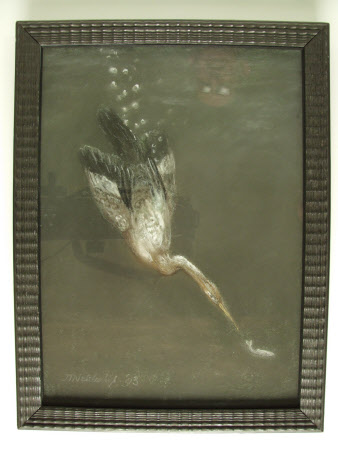Diving Heron
John Trivett Nettleship (Kettering 1841 - London 1902)
Category
Art / Drawings and watercolours
Date
1893
Materials
Pastel on paper
Measurements
381 x 273 mm (15 x 10 3/4 in)
Order this imageCollection
Shaw's Corner, Hertfordshire
NT 1275274
Summary
Pastel on paper, "Diving Heron" by John Trivett Nettleship (Kettering 1841 - London 1902), 1893. Bernard Shaw became friends with the animal artist Nettleship during the 1880s. A black and white heron dives under water within reach of small grey fish. Bubbles rise from the heron. Framed and glazed.
Full description
Bernard Shaw became friends with the animal artist John Trivett Nettleship (1841-1902) during the 1880s when the two men met at the Browning Society in London, founded in 1881 with the purpose of discussing the works of the poet Robert Browning. Shaw attended a lecture at the Browning Society in 1885 given by Nettleship on ‘Browning’s Development as Poet or Maker’. Shaw’s diaries also reveal that he encountered Nettleship’s paintings and drawings whilst working in London as an art critic, viewing his exhibitions of pastels (31 October 1890; 20 February 1892), and visiting his studio (2 August 1892). (Stanley Weintraub, ed., Bernard Shaw The Diaries, 1885-1897, 2 vols, p.663; 796; 841). Nettleship’s letters to Shaw survive in the British Library. In 1886 we find Nettleship writing to Shaw to thank him for writing about his work: ‘will you accept my cordial thanks for your mention of my Grosvenor picture in this week’s World… it is like water in the desert to find one’s work divined.’ (British Library Add MS. 50511, ff. 184-88, 11 May 1886). These letters also reveal that Nettleship was an avid reader of Shaw’s novels such as An Unsocial Socialist, and Cashel Byron’s Profession. The pastel of the Diving Heron, was probably purchased by Shaw at the exhibition of his work at the Carfax Gallery in 1903. Shaw owned shares in the Carfax Gallery, based in St. James’s in London. Nettleship had died in 1902, and the Carfax staged an exhibition of ‘Pastels and sketches by the late J.T. Nettleship’ in 1903. Nettleship’s wife Ada was a seamstress, who made the famous ‘beetle’ dress worn by Ellen Terry for her performances as Lady Macbeth. John and Ada’s daughter Ida Nettleship married Augustus John. (Alice McEwan, 2020)
Provenance
The Shaw Collection. The house and contents were bequeathed to the National Trust by George Bernard Shaw in 1950, together with Shaw's photographic archive.
Marks and inscriptions
"J.T. Nettleship '93" (Signed bottom left)
Makers and roles
John Trivett Nettleship (Kettering 1841 - London 1902)

